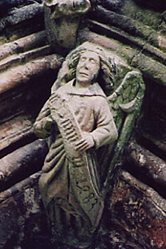 |
 |
 |
 |
 |
 |
 |
|
Fountains Abbey: History
Fountains Abbey: Buildings
|
Restoration work (4/10) By the time of John Darnton’s succession to the abbacy in 1478, the church at Fountains was in need of repair and modernisation. John undertook the necessary restoration and his work included the insertion of new windows with pictorial glass, which replaced geometric designs, re-roofing in lead and the addition of buttresses. His magnificent east window of nine lights in the Chapel of Nine Altars was particularly striking. Darnton clearly took great pride in his building work and wished to be remembered for his achievement, for these repairs bore his personal stamp. In the cracks above two window heads that were dangerous and needed to be filled, he inserted stones, carved with personal memorials. The east lancet light of the Chapel of the Nine Altars depicts an angel bearing a scroll, with the inscription ‘AD 1483’ below, to show the year in which this work was completed and thus the abbot responsible for its execution. A window-head in the south wall of the Chapel of the Nine Altars shows an angel bearing a shield, with an abbot’s head, mitred, above; this is presumably intended to represent Darnton; the figure supports two fish or dolphins, and beneath is a scroll and the figure of St James the Great of Compostela. On the exterior of this window-head another carved figure of an angel holds a tun, with ‘dern’ written across its breast, a pun on the abbot’s surname, ‘Darnton’; the eagle of St John is depicted above, an allusion to his Christian name. The great window that he built in the west wall of the nave shows the Virgin with Christ child, carved with Darnton’s rebus, namely, the eagle of St John bearing a crozier, perched on a tun, with the inscription ‘1494’. |
